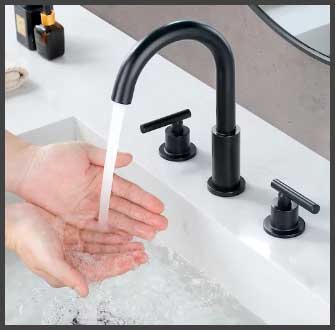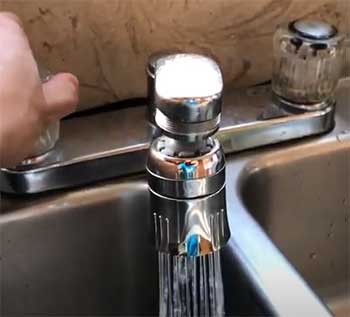When it comes to choosing bathroom fixtures, one question often puzzles homeowners: Should I opt for a 1.2 GPM (gallons per minute) faucet or a 1.5 GPM faucet?
The answer isn’t as straightforward as you might think. The real crux of the matter lies in your specific needs, preferences, and even your environmental consciousness.
Let’s delve into the details, shall we?
A Brief Comparison Table
| Aspects | 1.2 GPM Faucet | 1.5 GPM Faucet |
| Water Conservation | Excellent – Uses less water per minute, reducing overall water consumption. | Good – Uses more water than 1.2 GPM, but still better than older, inefficient faucets. |
| Water Pressure | Lower – Offers less water flow, which might be less satisfying for some users. | Higher – Provides a stronger water flow, which can be beneficial for tasks requiring more water pressure. |
| Utility Bills | Lower – With less water consumption, you can expect to save more on your water bills. | Higher – Despite its conservation properties, the higher water use of 1.5 GPM faucets will likely result in higher water bills compared to 1.2 GPM. |
| User Satisfaction | Variable – Some users might find the lower water pressure less satisfying for handwashing and similar tasks. | Variable – With its higher water flow, some users might find the 1.5 GPM faucet more satisfying to use. |
| Environmental Impact | Lower – The reduced water consumption of 1.2 GPM faucets results in a smaller environmental footprint. | Higher – Despite being better than older faucets, 1.5 GPM faucets have a larger environmental footprint than 1.2 GPM due to their higher water use. |
What’s In A GPM?

GPM refers to the amount of water a faucet dispenses per minute. The lower the GPM, the less water you’re using.
For instance, 1.2 GPM faucets use less water than their 1.5 GPM counterparts, making them potentially more eco-friendly and cost-effective.
However, there’s more to this than meets the eye.
Pros and Cons of 1.2 GPM Faucets
- Upsides of 1.2 GPM
The primary benefit of 1.2 GPM faucets is water conservation. These faucets are designed to reduce your water usage by a significant amount, which isn’t just great for the environment but also for your utility bill.
You can save hundreds of gallons of water every year, which is an attractive proposition for eco-conscious homeowners.
- Downsides of 1.2 GPM
However, every silver lining has a cloud. While 1.2 GPM faucets are eco-friendly, they may not provide the force needed for some tasks, such as quickly filling up a sink or washing away stubborn dirt.
Plus, some users may find the lower water pressure less satisfying during regular hand or face washing.
Pros and Cons of 1.5 GPM Faucets
- Advantages of 1.5 GPM

On the flip side, 1.5 GPM faucets offer more power, providing higher water flow for those tough-to-handle tasks.
These faucets are perfect for homeowners who value effectiveness over conservation.
And let’s not forget that these faucets can still be an upgrade in water conservation compared to older faucets that use more than 2.0 GPM.
- Disadvantages of 1.5 GPM
However, the 1.5 GPM faucets do use more water, which means a higher utility bill and a larger environmental footprint. If saving water is high on your priority list, the 1.5 GPM might not be your first choice.
Key Differences Between 1.2 and 1.5 GPM Bathroom Faucets
- Water Conservation
This is perhaps the most significant difference between 1.2 and 1.5 GPM faucets. The 1.2 GPM faucets are designed to maximize water conservation, using less water per minute.
On the other hand, 1.5 GPM faucets use slightly more water, making them less eco-friendly.
- Water Pressure
Water pressure is directly linked to GPM. The 1.2 GPM faucets tend to offer lower water pressure compared to 1.5 GPM faucets.
This means 1.5 GPM faucets are often better equipped to handle tasks requiring higher water flow, such as quickly filling up a basin or washing away stubborn dirt.
- Utility Bills
With lower water consumption comes lower water bills. If saving on utility costs is a priority for you, the 1.2 GPM faucet can be a more economical choice.
While 1.5 GPM faucets also contribute to water conservation, especially compared to older, less efficient faucets, they will not save as much water (and therefore money) as the 1.2 GPM faucets.
- User Satisfaction
Some users might find the lower pressure of the 1.2 GPM faucets less satisfying. For tasks like hand washing or face washing, the sensation of water pressure can be a deciding factor for some.
In such cases, the 1.5 GPM faucet, with its higher water flow, might be a better option.
- Environmental Impact
The difference in GPM also translates to the environmental impact. A faucet that uses less water contributes to less water waste and, therefore, has a smaller environmental footprint.
So if you’re looking to make your household more eco-friendly, the 1.2 GPM faucet might be the right choice for you.
While both 1.2 and 1.5 GPM faucets offer a balance between efficiency and conservation, they serve different needs. Choose wisely based on your specific requirements and preferences.
So, how do you decide between a 1.2 and 1.5 GPM faucet? The choice often comes down to personal preference and specific needs. If you’re an eco-friendly household, the 1.2 GPM may be your best bet. But if you prefer more powerful water flow, the 1.5 GPM could be the right fit.
Frequently Asked Questions (FAQ)
Yes, 1.2 GPM is excellent for a bathroom faucet, especially if you’re looking to conserve water and save on utility bills. It offers a reasonable flow for everyday tasks like hand and face washing.
A 1.5 GPM fixture is beneficial when you require a higher water flow, such as quickly filling up a basin or for tougher cleaning tasks. It might be particularly useful in high-use bathrooms or commercial settings.
Yes, 1.5 GPM is generally suitable for a kitchen faucet. The higher water flow can be beneficial for tasks like rinsing dishes or filling up pots and pans.
A good GPM for a faucet depends on the setting and the tasks you need it for. For standard household use, faucets between 1.2 and 1.5 GPM offer a good balance between water conservation and functionality.
Wrapping Up
In conclusion, the decision between a 1.2 and 1.5 GPM bathroom faucet isn’t a one-size-fits-all. Consider your household needs, your environmental commitment, and your budget before making a choice. And remember, every drop counts!
